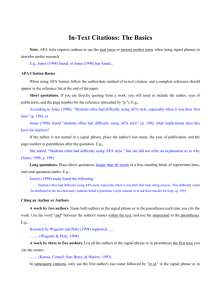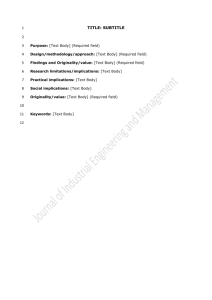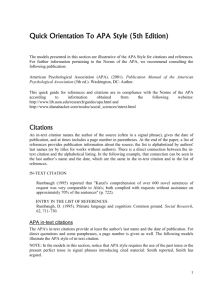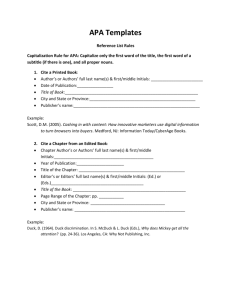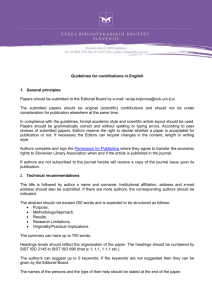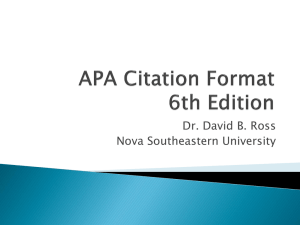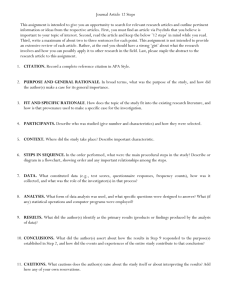APA - Marian High School
advertisement
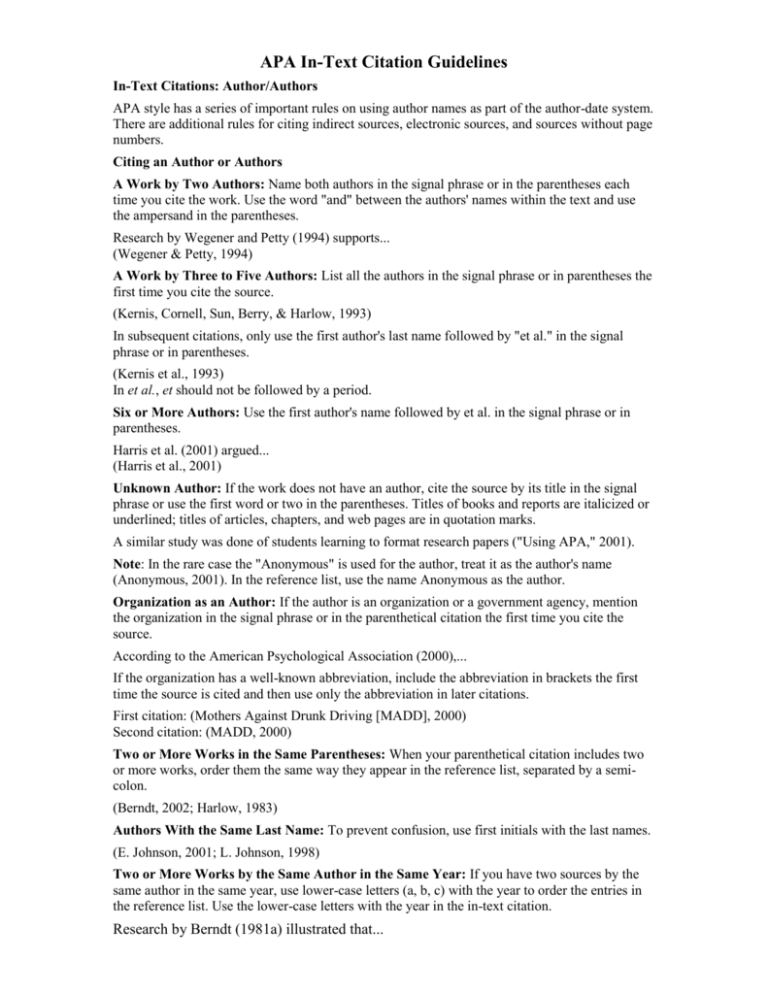
APA In-Text Citation Guidelines In-Text Citations: Author/Authors APA style has a series of important rules on using author names as part of the author-date system. There are additional rules for citing indirect sources, electronic sources, and sources without page numbers. Citing an Author or Authors A Work by Two Authors: Name both authors in the signal phrase or in the parentheses each time you cite the work. Use the word "and" between the authors' names within the text and use the ampersand in the parentheses. Research by Wegener and Petty (1994) supports... (Wegener & Petty, 1994) A Work by Three to Five Authors: List all the authors in the signal phrase or in parentheses the first time you cite the source. (Kernis, Cornell, Sun, Berry, & Harlow, 1993) In subsequent citations, only use the first author's last name followed by "et al." in the signal phrase or in parentheses. (Kernis et al., 1993) In et al., et should not be followed by a period. Six or More Authors: Use the first author's name followed by et al. in the signal phrase or in parentheses. Harris et al. (2001) argued... (Harris et al., 2001) Unknown Author: If the work does not have an author, cite the source by its title in the signal phrase or use the first word or two in the parentheses. Titles of books and reports are italicized or underlined; titles of articles, chapters, and web pages are in quotation marks. A similar study was done of students learning to format research papers ("Using APA," 2001). Note: In the rare case the "Anonymous" is used for the author, treat it as the author's name (Anonymous, 2001). In the reference list, use the name Anonymous as the author. Organization as an Author: If the author is an organization or a government agency, mention the organization in the signal phrase or in the parenthetical citation the first time you cite the source. According to the American Psychological Association (2000),... If the organization has a well-known abbreviation, include the abbreviation in brackets the first time the source is cited and then use only the abbreviation in later citations. First citation: (Mothers Against Drunk Driving [MADD], 2000) Second citation: (MADD, 2000) Two or More Works in the Same Parentheses: When your parenthetical citation includes two or more works, order them the same way they appear in the reference list, separated by a semicolon. (Berndt, 2002; Harlow, 1983) Authors With the Same Last Name: To prevent confusion, use first initials with the last names. (E. Johnson, 2001; L. Johnson, 1998) Two or More Works by the Same Author in the Same Year: If you have two sources by the same author in the same year, use lower-case letters (a, b, c) with the year to order the entries in the reference list. Use the lower-case letters with the year in the in-text citation. Research by Berndt (1981a) illustrated that... Personal Communication: For interviews, letters, e-mails, and other person-to-person communication, cite the communicator's name, the fact that it was personal communication, and the date of the communication. Do not include personal communication in the reference list. (E. Robbins, personal communication, January 4, 2001). A. P. Smith also claimed that many of her students had difficulties with APA style (personal communication, November 3, 2002). Citing Indirect Sources If you use a source that was cited in another source, name the original source in your signal phrase. List the secondary source in your reference list and include the secondary source in the parentheses. Johnson argued that...(as cited in Smith, 2003, p. 102). Note: When citing material in parentheses, set off the citation with a comma, as above. Also, try to locate the original material and cite the original source. Electronic Sources If possible, cite an electronic document the same as any other document by using the author-date style. Kenneth (2000) explained... Unknown Author and Unknown Date: If no author or date is given, use the title in your signal phrase or the first word or two of the title in the parentheses and use the abbreviation "n.d." (for "no date"). Another study of students and research decisions discovered that students succeeded with tutoring ("Tutoring and APA," n.d.). Sources Without Page Numbers When an electronic source lacks page numbers, you should try to include information that will help readers find the passage being cited. When an electronic document has numbered paragraphs, use the abbreviation "para." followed by the paragraph number (Hall, 2001, para. 5). If the paragraphs are not numbered and the document includes headings, provide the appropriate heading and specify the paragraph under that heading. Note that in some electronic sources, like Web pages, people can use the Find function in their browser to locate any passages you cite. According to Smith (1997), ... (Mind over Matter section, para. 6). Note: Never use the page numbers of Web pages you print out; different computers print Web pages with different pagination. Contributors:Joshua M. Paiz, Elizabeth Angeli, Jodi Wagner, Elena Lawrick, Kristen Moore, Michael Anderson, Lars Soderlund, Allen Brizee, Russell Keck. Summary:. A Work in an Anthology (like Norton) Last Name, First. (Year). Title of work used. In list editors (Eds.), Title of Anthology (pp. x-x). Published City, State: Publisher. Seegmiller, B. (1993). Pregnancy. In F.Denmark & M. Paludi (Eds.), Psychology of women: A handbook of issues and theories (pp. 437-474). Westport, CT: Greenwood. APA Reference List (Works Cited) Single Author Last name first, followed by author initials. Berndt, T. J. (2002). Friendship quality and social development.Current Directions in Psychological Science, 11, 7-10. Two Authors List by their last names and initials. Use the ampersand instead of "and." Wegener, D. T., & Petty, R. E. (1994). Mood management across affective states: The hedonic contingency hypothesis. Journal of Personality and Social Psychology, 66, 1034-1048. Three to Seven Authors List by last names and initials; commas separate author names, while the last author name is preceded again by ampersand. Kernis, M. H., Cornell, D. P., Sun, C. R., Berry, A., Harlow, T., & Bach, J. S. (1993). There's more to self-esteem than whether it is high or low: The importance of stability of selfesteem. Journal of Personality and Social Psychology, 65, 1190-1204. More Than Seven Authors List by last names and initials; commas separate author names. After the sixth author's name, use an ellipses in place of the author names. Then provide the final author name. There should be no more than seven names. Miller, F. H., Choi, M. J., Angeli, L. L., Harland, A. A., Stamos, J. A., Thomas, S. T., . . . Rubin, L. H. (2009). Web site usability for the blind and low-vision user. Technical Communication, 57, 323-335. Organization as Author American Psychological Association. (2003). Unknown Author Merriam-Webster's collegiate dictionary (10th ed.).(1993). Springfield, MA: MerriamWebster. NOTE: When your essay includes parenthetical citations of sources with no author named, use a shortened version of the source's title instead of an author's name. Use quotation marks and italics as appropriate. For example, parenthetical citations of the source above would appear as follows: (Merriam-Webster's, 1993). Two or More Works by the Same Author Use the author's name for all entries and list the entries by the year (earliest comes first). Berndt, T. J. (1981). Berndt, T. J. (1999). When an author appears both as a sole author and, in another citation, as the first author of a group, list the one-author entries first. Berndt, T. J. (1999). Friends' influence on students' adjustment to school. Educational Psychologist, 34, 15-28. Berndt, T. J., & Keefe, K. (1995). Friends' influence on adolescents' adjustment to school. Child Development, 66, 1312-1329. Online Articles Online articles follow the same guidelines for printed articles. Include all information the online host makes available, including an issue number in parentheses. Author, A. A., & Author, B. B. (Date of publication). Title of article.Title of Online Periodical, volume number(issue number if available). Retrieved from http://www.someaddress.com/full/url/ Bernstein, M. (2002). 10 tips on writing the living Web. A List Apart: For People Who Make Websites, 149. Retrieved from http://www.alistapart.com/articles/writeliving Online Database Author, A. A., & Author, B. B. (Date of publication). Title of article.Title of Journal, volume number, page range. Retrieved from http://www.someaddress.com/full/url/ Smyth, A. M., Parker, A. L., & Pease, D. L. (2002). A study of enjoyment of peas. Journal of Abnormal Eating, 8(3), 120-125. Retrieved from http://www.articlehomepage.com/full/url/ Interviews, Email, and Other Personal Communication No personal communication is included in your reference list; instead, parenthetically cite the communicator's name, the phrase "personal communication," and the date of the communication in your main text only. (E. Robbins, personal communication, January 4, 2001). A. P. Smith also claimed that many of her students had difficulties with APA style (personal communication, November 3, 2002).

